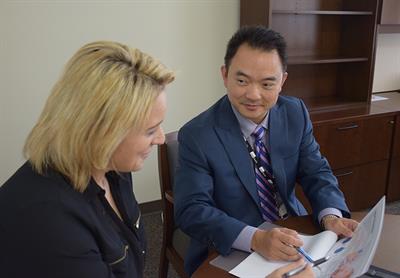
UTMB physicians have been practicing telemedicine for more than 20 years, delivering care via video conferencing to Texas prison inmates, cruise ship passengers, researchers in Antarctica and patients in rural parts of the state.
So it only makes sense for UTMB to lead the coordination and implementation of a UT System initiative connecting all eight UT health care institutions under one statewide telemedicine network. Approved by the Board of Regents last year, the UT System Virtual Health Network (VHN) will build on the system’s existing telehealth capabilities and will allow more patients to have access to specialty care without driving hundreds of miles.
“It’s very exciting to see technology evolve,” said Alex Vo, PhD, UTMB’s vice president of telemedicine and health services technology. “But what’s even more exciting is to see how we are using technology to bridge access to care that has traditionally had barriers in the past.”
Currently in the first phase of a four-year implementation, the UT-VHN will provide coordinated outbound and inbound services from UT health sciences centers and medical schools into care settings such as other hospitals and clinics, nursing facilities, schools, employee work sites and even patient homes.
“The VHN offers a solution that really goes to the heart of the problem for patients in medically underserved areas,” said Mari Robinson, JD, director of telehealth at UTMB. “It allows patients access to a high quality of care in a large variety of medical specialty areas without the burden of traveling to one of the major metropolitan areas of the state.”
The network is among Chancellor Bill McRaven’s “Quantum Leaps,” which are bold initiatives for the future of the UT System. Vo, who has worked on the UT-VHN since its inception, described how the network will provide fast and efficient access to specialists across the state.
“Under the VHN, patients in the far eastern or western areas of Texas who normally go to a certain medical/health sciences center can reach across the network to UT Southwestern or UTMB or other institutions for various specialties that their local area can’t provide,” he said.
For example, if a primary care provider at a satellite clinic associated with the UT-VHN senses that their patient needs a specialty consult in neurology, they can look across the entire network to book an appointment in that specialty area. Then, the patient would be seen by the specialist at their local clinic via telemedicine.
“That way, the patient remains in the community and the local provider has an added value for that patient because now they have access to the UT network of specialists,” said Vo.
Along with improving access to care, the UT-VHN is also expected to save costs as patients are provided quality, coordinated care faster and closer to home, thereby mitigating emergency room visits and acute problems.
As a participant and anchor institution, UTMB is currently leveraging its telehealth expertise to assess technical, business and clinical operations at all eight UT System health-related institutions. A small team has been traveling across the state to learn about each institution’s telehealth capabilities, and will then recommend a path forward to directly connect all institutions.
By 2020, Vo said the UT-VHN will set an unprecedented model of care delivery.
“By the nature of our connections, UT medical institutions will be able to cast a wide net of service across rural, urban and underserved areas—breaking down barriers and truly bridging the gap in care access.”